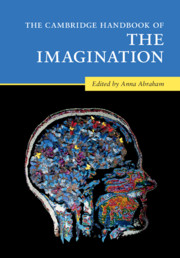Book contents
- The Cambridge Handbook of the Imagination
- The Cambridge Handbook of the Imagination
- Copyright page
- Dedication
- Contents
- Figures
- Contributors
- Acknowledgments
- 1 Surveying the Imagination Landscape
- Part I Theoretical Perspectives on the Imagination
- Part II Imagery-Based Forms of the Imagination
- Part III Intentionality-Based Forms of the Imagination
- 19 Continuities and Discontinuities Between Imagination and Memory: The View from Philosophy
- 20 Imagining and Experiencing the Self on Cognitive Maps
- 21 The Neuroscience of Imaginative Thought: An Integrative Framework
- 22 Imagination and Self-Referential Thinking
- 23 Imaginary Friends: How Imaginary Minds Mimic Real Life
- 24 Imagination and Moral Cognition
- 25 Moral Reasoning: A Network Neuroscience Perspective
- 26 The Future-Directed Functions of the Imagination: From Prediction to Metaforesight
- Part IV Novel Combinatorial Forms of the Imagination
- Part V Phenomenology-Based Forms of the Imagination
- Part VI Altered States of the Imagination
- Name Index
- Subject Index
- References
23 - Imaginary Friends: How Imaginary Minds Mimic Real Life
from Part III - Intentionality-Based Forms of the Imagination
Published online by Cambridge University Press: 26 May 2020
- The Cambridge Handbook of the Imagination
- The Cambridge Handbook of the Imagination
- Copyright page
- Dedication
- Contents
- Figures
- Contributors
- Acknowledgments
- 1 Surveying the Imagination Landscape
- Part I Theoretical Perspectives on the Imagination
- Part II Imagery-Based Forms of the Imagination
- Part III Intentionality-Based Forms of the Imagination
- 19 Continuities and Discontinuities Between Imagination and Memory: The View from Philosophy
- 20 Imagining and Experiencing the Self on Cognitive Maps
- 21 The Neuroscience of Imaginative Thought: An Integrative Framework
- 22 Imagination and Self-Referential Thinking
- 23 Imaginary Friends: How Imaginary Minds Mimic Real Life
- 24 Imagination and Moral Cognition
- 25 Moral Reasoning: A Network Neuroscience Perspective
- 26 The Future-Directed Functions of the Imagination: From Prediction to Metaforesight
- Part IV Novel Combinatorial Forms of the Imagination
- Part V Phenomenology-Based Forms of the Imagination
- Part VI Altered States of the Imagination
- Name Index
- Subject Index
- References
Summary
This chapter examines the relationship between mental state reasoning skills and imagination; specifically how and why children who create imaginary companions (ICs) differ in these skills from children who do not have imaginary playmates. This chapter introduces mental state reasoning, and explains its links to imagination and other variables, while exploring how this construct is measured. It then moves on to investigate IC play and consider how a child’s creation of a pretend mind is thought to improve his or her ability to reason about real minds. The chapter also includes a short history of the imaginary companion, as well as an overview of how science has viewed this construct, a clarification of what type of play is classified as IC play, and which groups of children might be more likely to play with these entities. Toward the end of the chapter, research on mental state reasoning and IC status is reviewed, and theoretical viewpoints on why these children excel in mental state reasoning are laid out. The chapter closes with a discussion of future explorations for this field in terms of causal direction and new forms of therapeutic play intervention.
- Type
- Chapter
- Information
- The Cambridge Handbook of the Imagination , pp. 373 - 389Publisher: Cambridge University PressPrint publication year: 2020
References
- 3
- Cited by



